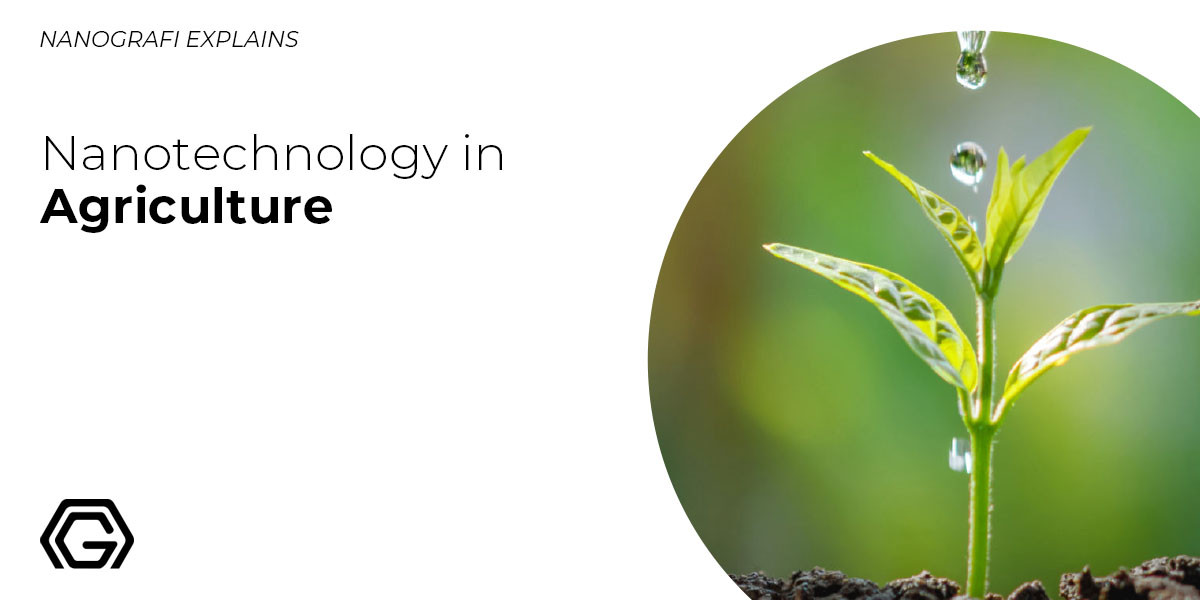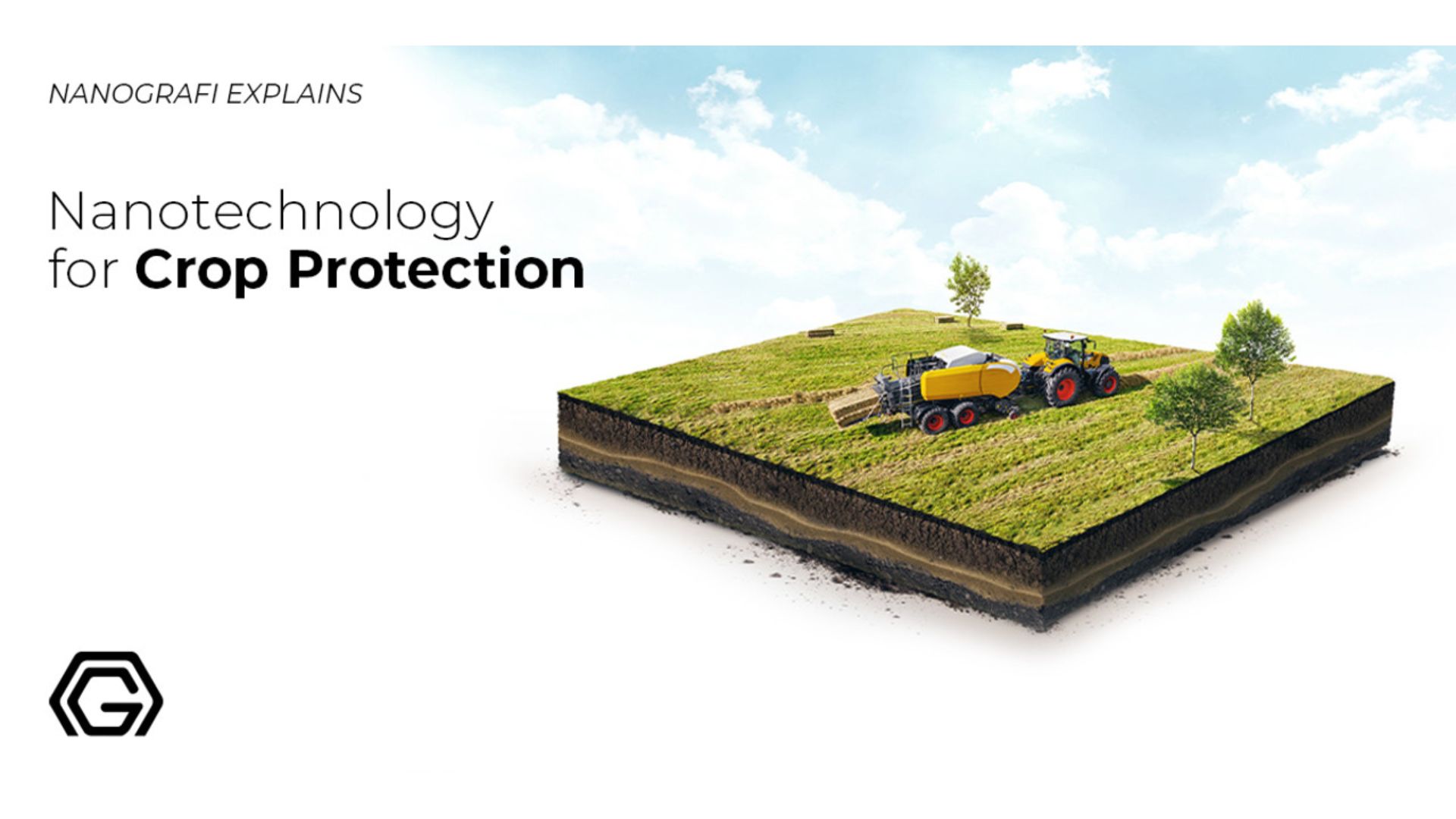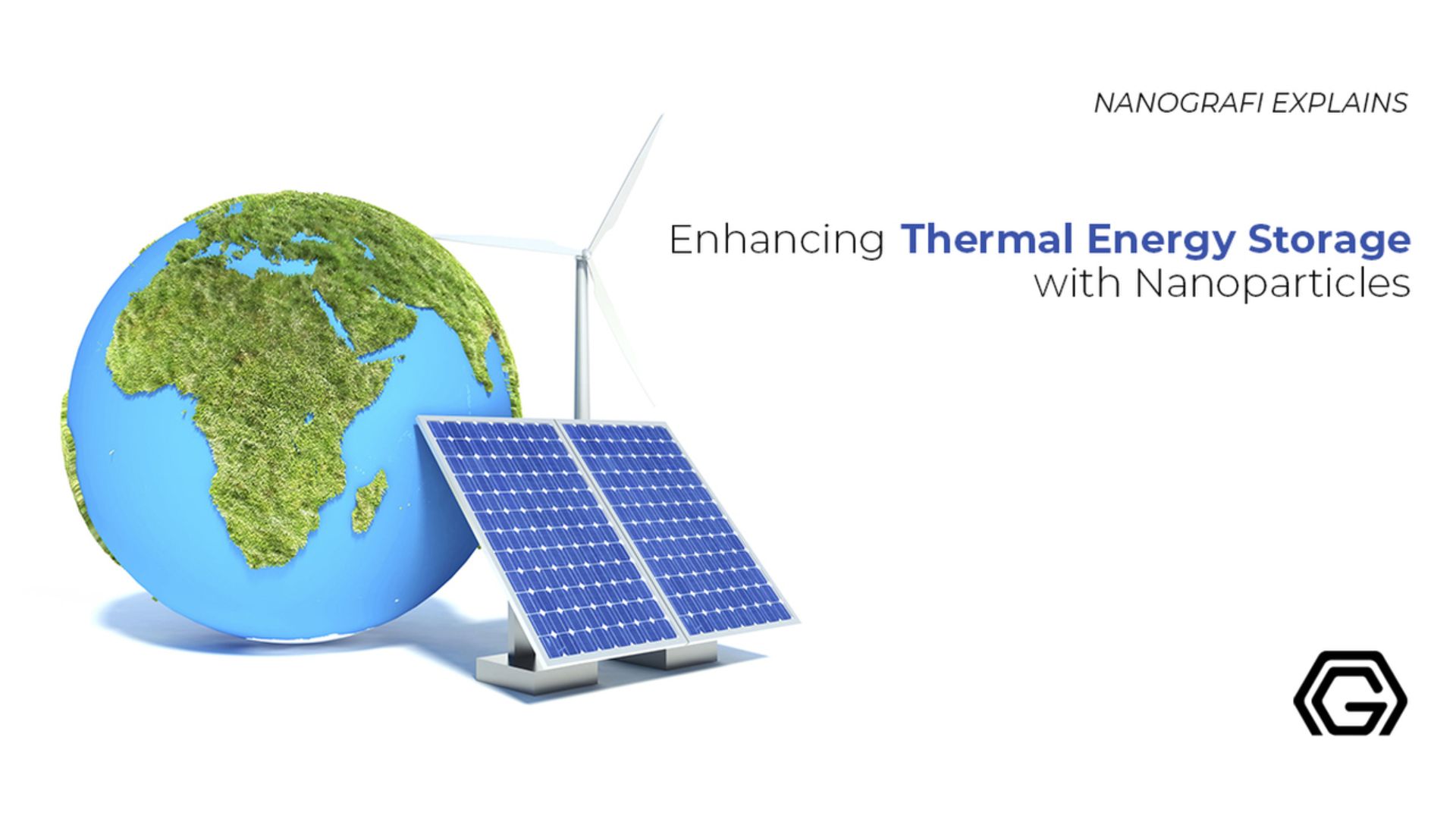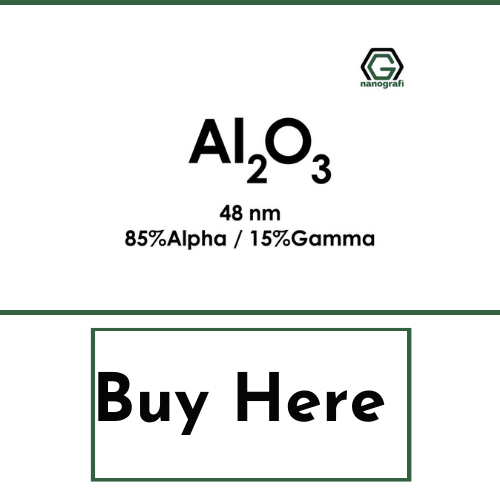Nanotechnology in Agriculture
The improvement in agriculture is crucial for the resolving of problems that comes with increasing food consumption.
Nanotechnology offers promising results in the improvement of key aspects in agriculture such as soil quality, agrochemical efficiency, environmental protection, and animal production efficiency.
Introduction
The global population has been rapidly increasing each year and has reached 7.8 billion as of July 2020 with 59% living in Asia. This number is expected to reach 9.5 billion by 2050. One of the most significant effects of an increasing global population is accordingly increasing food consumption and the importance of agriculture. Agriculture is the largest interface between nature and human species meeting the nutritional demands of the ever growing population on earth. However, several challenges and problems in agriculture need tending and development in order to meet the great food demand while also preserving nature.
The Need of Nanotechnology in Agriculture
Aside from the obvious increasing food demand, there are also problems with food shortages due to environmental effects such as poor feed quality, animal diseases, storms, poor soil quality, droughts, and floods in developing countries where a considerable portion of the global population lives. These problems are also accompanied by the limit of natural resources such as production land, water, soil, etc. The competition between the industry and agriculture for the limited production land has left little room for the agricultural activities with the growing popularity of the industry. The combined effect of all these problems in agriculture requires urgent development in agricultural studies to increase the efficiency and volume of agricultural production while decreasing the required production land area. Another concern related to agricultural activities is the negative effect of agrochemicals on the environment due to the agglomeration of these powerful chemicals such as pesticides and fertilizers. Nanotechnological solutions have been investigated as a way to overcome the crucial problems in agriculture. Improving soil quality is perceived as the first step to improve agricultural activities in terms of farming. Hence, several different nanotechnological solutions such as hydrogels, nanoclays, and nanozeolites have been suggested to enhance the water holding capacity of soil along with nanopolymers, carbon nanotubes, metal, and metal oxide nanoparticles which are used in the removal of environmental contaminants. Further applications of nanotechnology are related to enhanced agrochemicals, monitoring of chemicals, soil and water treatment, and animal production. Of course, all these possible applications of nanotechnology require a detailed assessment of toxic effects on human health and the environment in order to achieve feasible applications.
Nano-Inspired Agrochemicals
Agrochemicals such as pesticides and fertilizers are important players in agricultural activities. However, when agrochemicals are applied through conventional methods they are prone to decompose rapidly or to be removed by external factors such as wind, sunlight, and rain. Due to the inefficient use of agrochemicals in conventional methods, most of these chemicals cannot reach the targeted species and become useless. Periodic application is required to make up for unused agrochemicals which increases the negative environmental effect of these chemicals. On the other hand, nanotechnology inspired agrochemicals show great potential to overcome these challenges due to their enhanced properties in nano-scale. Therefore, nanofertilizers and nanopesticides have recently attracted a lot of attention.
On the road to sustainable agriculture, the development of nanofertilizers is regarded as a promising approach. Nanofertilizers significantly increase plant growth and product yield while supporting environmental protection. Thanks to nanotechnology, the nutrients are released s into the soil gradually and in a targeted/controlled manner. This may prevent eutrophication and run-off causing water and soil pollution. In nanofertilizer materials nutrients can be encapsulated by nanomaterials, coated with a thin protective nanoscale polymeric film, or delivered as nano-emulsions or nanoparticles (NPs) Nanofertilizers may contain nano zinc, silica, iron and titanium dioxide, ZnCdSe/ZnS core-shell QDs, InP/ZnS core-shell QDs, Mn/ZnSe QDs, zeolites, carbon nanotubes (CNTs) and gold nanorods. These complexes can supply one or more nutrients to the plants and enhance their growth, or can improve the performance of conventional fertilizers. Nanofertilizers increase plant-uptake efficiency of nutrients and reduce the adverse impacts of conventional fertilizer application. High specific surface area and enhanced surface chemistry of nanomaterials provide high nutrient intake and gradual release of the nutrients which reduces nutrient loss as well as environmental risks. Zeolites are an important example of such nanomaterials providing high specific surface area and d a high selection toward plant macronutrients. On the other hand, titanium oxide (TiO 2) and CNTs containing nanofertilizers improve the plant photosynthesis efficacy and enzyme activity without the need for essential nutrients which leads to an increase in plant germination and growth. In addition to the engineered nanomaterials, nanoemulsions of macro or micronutrients are also utilized in nanofertilizers enabling the nutrient to be delivered homogenously and increasing the interaction surface between plants and nutrients.
Along with fertilizers, pesticides are important players in agriculture as well. Even though pesticides are essential, they pose a great threat to the environment and human health. Just as fertilizers, the ineffective delivery of pesticides creates the need for regular application and consequently a significant amount of accumulation in the soil and on the plants. This is why, nanoengineered pesticides, nanopesticides, have recently been suggested as a solution to these problems. Several different methods are pursued in nanopesticide applications. One of the nanopesticide applications includes carriers such as polymeric nanospheres, nanocapsules, nanogels, nanofibers, solid lipid nanoparticles, liposomes, or clay nanotubes (halloysite) for targeted delivery and controlled release of pesticide particles. On the other hand, engineered nanoparticles such as silver, copper, metal oxide nanoparticles, and nanoclay are also utilized as nanopesticides. Similar to fertilizers, pesticide molecules can also be incorporated into nanoemulsions and nanodispersions increasing the bioavailability of the active ingredient. Nanopesticides claim importance based on their ability to decrease the amount of active ingredient used, the release of harmful chemicals to non-target organisms thus reducing the development of resistance as well as their ability to provide greater solubility, mobility, and durability.
To get more information about the role of nanotechnology in agriculture,
you can read our blog post here.
Nanotechnology for Monitoring Chemicals
The dependency on chemical materials in agriculture brings the necessity of environmental protection measurements since environmental security is an important matter considerably affecting the public well-being. Detection and monitoring of environmental pollutants caused by agricultural activities is a major part of assuring environmental security. The development of sensitive and selective monitoring systems is therefore crucial for environmental friendly agriculture. In this concept, enhanced chemical activity and surface area of nanomaterials is a great asset for real time monitoring of a wide variety of fertilizers, herbicide, pesticide, insecticide, heavy metals, organic pollutants, and pathogens. These “nanosensors” are analytical devices fabricated for monitoring physicochemical properties in places otherwise difficult to reach, offering greater sensitivity, low detection limits, selectivity, fast detection rates, and more portability than conventional detection techniques. These unique properties of nanosensors are also utilized for the improvement of detection limits for bacterial, viral, and fungal pathogen determination in plants. In addition to possible toxicants and pathogens, the soil quality in terms of moisture levels, soil pH, fertility and temperature, crop nutrient status, and concentrations can also be monitored with nanosensors. Therefore, a network of nanosensors providing analyses of different environmental, crop, and pest variables would create valuable data for agricultural activities. These analyses are great assets for choosing fertilization strategies, reduction of inputs, and better management of time and environmental resources. The most commonly studied nanomaterials in nanosensor applications are metal (gold, silver, cobalt, etc.) NPs, CNT, magnetic NPs, and QDs. Even though nanosensor studies have come a long way and shown great improvements, nanosensor systems still require a detailed investigation to assess sensitivity to common toxicant residues, pathogens, and environmental parameters, the need for a multi-residue identification in the real agricultural scenario, and the fabrication and validation of suitable detection instruments. Moreover, the effect of nanomaterials on the environment must be investigated thoroughly.
Nanotechnology for Water and Soil Treatment
So far we have established the importance of monitoring environmental pollution and the nanomaterials’ in this process. However, establishing an effective and holistic approach requires water and soil treatment processes in addition to the monitoring of pollutants. Soils and groundwater are contaminated by pollutants from natural and anthropogenic activities posing a great risk to human health or the environment. Agriculture is both the source of this pollution and affected by polluted soil and water. Hence, developing water and soil treatment processes is indispensable. The studies on this subject have recently focused on nanotechnology and nano engineered materials hoping to develop new cost-effective and powerful methods. Soil and water treatment involves the removal of pollutants such as heavy metals/metalloids, dyes, and organic pollutants. Nano-remediation works through transformation and detoxification of these pollutants with the use of reactive nanospecies. The high surface area of nanomaterials enhances the chemical activity of remediation materials while small-sized materials enable a wider distribution compared to larger, macro-sized particles. Nano-remediation has the potential to reduce the overall costs of cleaning up large-scale contaminated sites, reduce clean-up time, eliminate the need for treatment and disposal of contaminated soil, and reduce some contaminant concentrations to near zero-all in situ.
Various nanoparticles including metal, metal-oxide, and bimetallic NPs, carbon nanotubes and fibers have been investigated for soil and water treatment. Amongst these options, zero-valent iron nanoparticles (ZVI-NPs) have attracted considerable attention due to their low cost and low toxicity. ZVI-NPs acting as electron donor molecules in redox reactions are effective in the removal of heavy metals and chlorinated particles from soil and water. Furthermore, ZVI-NPs are utilized in the elimination of nitrogen from activated sludge and phosphorus from wastewater. However, the rapid agglomeration and possible reaction with undesired species have limited the wide range use of ZVI-NPs. Another promising group of nanomaterials in soil and water treatment is metal-oxide nanoparticles such as magnetite (Fe 3O4), aluminum/titanium containing composites (Al 2O3/TiO2), bimetallic composites, and carbonaceous nanomaterials. Magnetite or other iron oxides are advantageous due to their redox cycle, ion exchange, high affinity for contaminants, and magnetic properties. These magnetic properties of iron oxides provide ease of removal from the water after the treatment process making it an easy cost-effective method. Bimetallic compounds consisting of iron and different metal such as palladium, silver, and nickel are also utilized in soil and water treatment for the removal of dyes, heavy metals, and halogenated compounds. Ag/Fe composites are especially effective in the antibacterial treatment of water. These composites can be treated with carboxymethyl cellulose, polymers, and surfactants for better stabilization and prevention of agglomeration. Al 2O3/TiO2 is considered in the removal of heavy metals such as lead and cadmium from soil and water. However, metallic compounds require caution due to their possible toxic effects and reactive nature with undesired targets. Carbonaceous nanomaterials are valuable assets in the removal of undesired organic compounds such as halogenated organics, polychlorinated biphenyls, polycyclic aromatic hydrocarbons, and volatile organic compounds as well as herbicides, industrial dyes, and heavy metals in water. Nanomaterials worth the attention not just for their unique properties but also for their ability to work in-situ or ex-situ depending on the requirement. However, there are still aspects of nano-remediation methods that need improvement including regeneration and reusability, large-scale application, and efficiency in wastewaters and contaminated soils. Furthermore, their applicability in-field must be further investigated to develop feasible systems.
If you are interested in the utilization of nanotechnology in sustainability,
you can read our blog post here.
Nanotechnology in Animal Production
Livestock, poultry, and aquaculture are also related to agriculture and constitute a big part of it. These agricultural activities play a great part in human nutrition and consequently have grown along with the increasing population. The main challenges in animal production are production efficiency, animal health, feed nutritional efficiency, diseases, product quality and value, by-products and waste, and environmental footprints. Nanotechnological solutions have been offered for all of these problems in animal production. Amongst all, feed efficiency arguably holds the most important place since it affects many other problems either directly or indirectly. Improving feeding efficiency reduces feed demand, waste production, environmental effects, and cost. Improving feed efficiency is especially important in developing countries where feed quality is usually is at undesired levels. Nanotechnology can be used to enhance the nutritious value and efficiency of feeds. Nano delivery systems such as micelles, liposomes, nano-emulsions, biopolymeric nanoparticles, protein-carbohydrate nanoscale complexes, solid nano lipid particles, dendrimers, and others have been developed for the efficient delivery of nutrients. These delivery systems provide better adaptability, high absorption, bioavailability, and better solubility increasing the feed efficiency. Improving feed efficiency also affects the product value and quality ensuring the production of animal-derived food in line with health recommendations and consumer expectations. These products help in the prevention of chronic human diseases such as cancer and atherogenesis For example, the nanotechnology-based delivery of nutrients helps to control the biosynthesis and concentration of CLA and VA in the milk fat. Similarly, the same delivery systems in nutrition delivery can be used for the selective drug delivery and controlled delivery of drugs in treatments or preventative applications improving the life quality of animals. Drugs and vaccines developed through nanotechnology are relatively more effective and cheaper than their conventional counterparts. Using nano-enhanced drugs requires less active ingredients reducing the environmental effects and possible antibiotic resistance. Nanotechnology is also employed in the diagnostics of common or crucial diseases such as bovine mastitis, tuberculosis, respiratory disease complex, Johne's disease, avian influenza, mad cow disease, avian influenza, H1N1 influenza, Ebola virus, Nipah virus and porcine reproductive and respiratory syndrome (PRRS). Thanks to nanotechnology, the detection and diagnostics systems can become highly specific and sensitive, can detect multiple samples at a time, are time-saving, robust, have on-board signal processing, and are convenient to use, portable and economical.
Toxicological Concerns of Nanomaterials Used in Agriculture
Exposure to nanoparticles is not a new concept emerged with nanotechnology. Natural or industrial sources such as forest fires have been releasing nanomaterials to the environment long before the development of nanotechnology. The human body has developed mechanisms to reduce the effect of these nanomaterials and filter undesired particles while in nature the life span of these nanoparticles is considerably short due to agglomeration and dissolving in water. However, the response of the human body and environment to the engineered nanoparticles might be different due to their protective coatings and carefully adjusted sizes. This is why a detailed investigation of the toxicity of engineered-nanomaterials is crucial. Even though it is a complex mission, the relationship between the particles and biological reactivity as well as the dose-response relationship must be assessed carefully. The effect of nanomaterials becomes significant especially in the case of long term exposure which points out that occupational risk must be taken into consideration. Clearly, nanotechnological agriculture is a new field to be assessed and regulated according to comprehensive studies on the subject.
Conclusion
Agriculture is the backbone of human nutrition and has considerably grown with the growing global population. However, current agricultural methods are not sufficient enough to meet the demands of increasing population and the expectancy of society. Furthermore, conventional agrochemicals are ineffective and cause serious damage to the environment and human health because of recursive applications. This is why studies have been conducted to improve agricultural activities in terms of efficiency, cost, time-costs, and environmental effects. Amongst these studies, nanotechnology has recently attracted attention. Nanoengineered materials are utilized in improving soil quality, developing effective nanofertilizers and nanopesticides, monitoring chemicals both in soil and in aqueous media, water and soil remediation, and animal production. Soil quality is improved by incorporating water-holding materials such as zeolites and nanoclays as well as materials to eliminate contaminants from the soil. The star players of agriculture, fertilizers, and pesticides, have also been enhanced with the use of nanotechnology since the high surface area, chemical activity, and solubility of nanomaterials are desirable. Nanofertilizers and nanopesticides offer effective use and homogenous distribution of active ingredients, cost-effective application; reduce environmental damage by the strong chemicals in fertilizer and pesticides. The protection of the environment and human health begins with the monitoring and control of chemicals in soil and water. Nanotechnological solutions provide ease of operation during the monitoring process by enabling access to areas that are otherwise hard to reach as well as sensitivity and selectivity to the detection process. The next step in the protection of the environment and human health is the soil and water remediation. Nanotechnology also offers smart solutions to these processes during the extraction of undesired materials such as heavy metals, organic components, and dyes. Nanoparticles utilized in soil and water remediation are iron oxides, carbonaceous nanomaterials, bimetallic nanomaterials, and Al 2O3/TiO2. In addition to farming, animal production is also affected by nanotechnology especially in the improvement of feed efficiency, animal health, and ensuring product quality and value. Feed efficiency is improved by enriching the nutrient content of conventional feeds as well as using nano delivery systems. These systems include micelles, liposomes, nano-emulsions, biopolymeric nanoparticles, protein-carbohydrate nanoscale complexes, solid nano lipid particles, dendrimers, and others. Improving feed efficiency also affects the product value and quality ensuring the production of animal-derived food in line with health recommendations and consumer expectations. Animal health is a problem that influences steady production and causes economical damage. Nano drug delivery systems similar to nutrient delivery systems are utilized in the treatment of diseases while detection and diagnostic methods based on nanotechnology offer the development of specific, sensitive, effective, and portable equipment. Of course, such nanotechnological solutions still need a clear assessment of possible toxic effects of nanomaterials. All in all, it is clear that agriculture is an integral part of human life and nanotechnology has great potential for the improvement of the out-dated applications in agriculture.
To get more information, you can visit Blografi.
References
- 1.Iavicoli, I., Leso, V., Beezhold, D. H., & Shvedova, A. A. (2017). Nanotechnology in agriculture: Opportunities, toxicological implications, and occupational risks. Toxicology and applied pharmacology, 329, 96-111.
- 2.Prasad, R., Bhattacharyya, A., & Nguyen, Q. D. (2017). Nanotechnology in sustainable agriculture: recent developments, challenges, and perspectives. Frontiers in microbiology, 8, 1014.
- 3.Fraceto, L. F., Grillo, R., de Medeiros, G. A., Scognamiglio, V., Rea, G., & Bartolucci, C. (2016). Nanotechnology in agriculture: which innovation potential does it have?. Frontiers in Environmental Science, 4, 20.
- 4.Ditta, A. (2012). How helpful is nanotechnology in agriculture?. Advances in Natural Sciences: Nanoscience and Nanotechnology, 3(3), 033002.
- 5.Rai, M., & Ingle, A. (2012). Role of nanotechnology in agriculture with special reference to management of insect pests. Applied microbiology and biotechnology, 94(2), 287-293.
- 6.Mousavi, S. R., & Rezaei, M. (2011). Nanotechnology in agriculture and food production. J Appl Environ Biol Sci, 1(10), 414-419.
Recent Posts
-
Advanced Materials for Unmanned Aerial Vehicle (UAV) Protection Against Laser
Consider a UAV on a critical mission, rendered inoperative by a sudden laser attack. With the increa …26th Jul 2024 -
Simulation and Modeling of Material Properties
Our world is composed of a dazzling array of materials, each with its own unique properties that dic …19th Jul 2024 -
Advanced Coatings for Superior Corrosion and Wear Resistance
Corrosion and wear pose significant challenges across various industries, leading to substantial eco …12th Jul 2024








